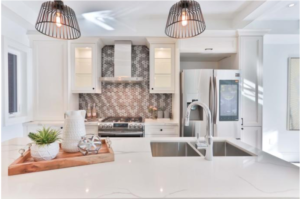At first glance, you might be wondering what architects and chefs have in common and comparing the two may seem odd. But the two professions actually have several similarities. And it’s these traits that separate the ordinary professionals from the extraordinary. Read on to find out more.
 Blueprints & Recipes
Blueprints & Recipes
Now, changing course in the middle of a NYC kitchen design project, and disregarding blueprints and plans is a bit more serious and can even result in a lawsuit.
This isn’t to say you can’t make any changes because that would take out all of the creativity. The main point to make is that any changes in the basic recipe or blueprint must be made in an orderly fashion with all involved notified.
Whether the end product is a 12-course meal or Manhattan Brownstone renovation – it’s created by a team. That’s why it’s essential that everyone knows what’s happening and is aware of any changes. “Just like the analogy that oil and water don’t mix, architectural plans without every detail or change in plans without properly updating the scope and letting the general contractor know doesn’t mix either”, says NYC general contractor, Aaron Borenstein.
 Keeping the General Contractor Informed
Keeping the General Contractor Informed
Cooks & Contractors – A beautiful new home renovation starts with a vision from the architect, and it’s carried out by the contractor. Professionals pay attention to the smallest of details to ensure what the client asked for is delivered. And to do that, the contractor cannot function without measurements and material lists that are updated continuously when changes are made.
Just imagine what would happen if the cook had no idea the chef changed the menu from Italian to Thai. The dinner guests may be presented with something they weren’t expecting – and not in a good way. The same thing goes for a contractor when an architect doesn’t keep them informed of changes including new measurements and material lists. The client might not get what they asked for.
Capturing the Client’s Vision
Regarding Food – In every part of the world socializing revolves around food. People gather to celebrate over a meal and experience the joy of being together. In fact, it’s easy to see that food is one of the loudest and most recognizable voices of culture to identify. When you recall places you’ve visited, it’s easy to remember the local dishes and atmosphere of restaurants and homes you dined in.
Let’s start with the basics – a plan or a recipe. It’s easy to see the similarities between designs and recipes. Not only because you can refer back to them when you need to, but by following a basic recipe, you can be sure of creating a delicious delight.
On the other side, departing from a tried and true cookbook and just throwing together ingredients can result in gastronomic disaster. As professionals, chefs and bakers can roll with changes especially when it comes to shopping for fresh ingredients. They know the best substitutions and can make fast changes in the menu when needed. The same goes for the contractor, which in this analogy you could consider him the “cook.” When the chef keeps the cook informed of ingredient and menu changes – the dish is a success. When the chef forgets to let the cook know what’s happening, you get disaster.
Regarding Architecture – Just as food has culture and personality so does construction and renovation. It starts with the clients’ vision, influenced by their background and tastes and to that is added their socializing preferences. For example, one of the most in-demand home improvement projects is a kitchen remodel. Probably because in many families the kitchen is the most important part of the home. Design tastes range from open modern design with calm and uncluttered spaces or large country kitchens with islands for gathering.
As with planning a menu, being prepared is paramount to make sure that you have enough lead time for all supplies to arrive. This is especially true if you’re under a tight deadline, but the client wants custom kitchen cabinets from Europe. In that case, it may be time to come up with another alternative. This is why it’s vital for the architect to be in close touch with the contractor. Otherwise, the entire project can go over budget and take much longer than it should.
 The Beauty of Collaboration
The Beauty of Collaboration
Success starts with the idea that’s communicated to the team via recipes and blueprints. The initial concept is tested and retested until victory is achieved. In cooking and baking, it’s adding and removing ingredients to come up with just the right combination to delight the taste buds.
In construction and renovations, it starts with a close inspection that carries through to blueprints. Once walls are opened up, and demo begins it may be time to update the plans. You can tell when you have a good architect because they always keep the team updated. And especially without communication from the architect in NYC, contractor and client, renovations get stalled, go over budget and the final product may not be what the client envisioned.
Success Begins & Ends with Collaboration
For both chefs and architects, success happens when they elevate the mere routine into the extraordinary; and that starts with a concept and flows through to collaboration. Home Evolutions Corp. is here to make your next renovation project a collaborative success. We welcome the opportunity to work with your architect to create a beautiful project.
